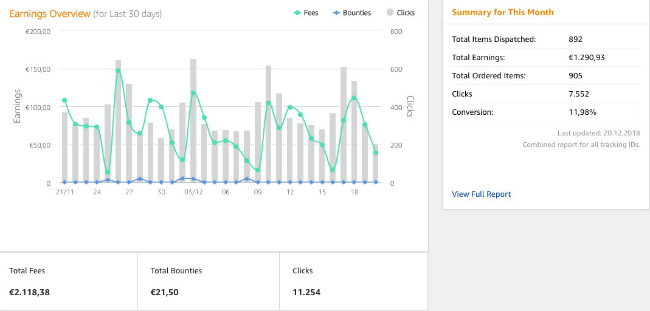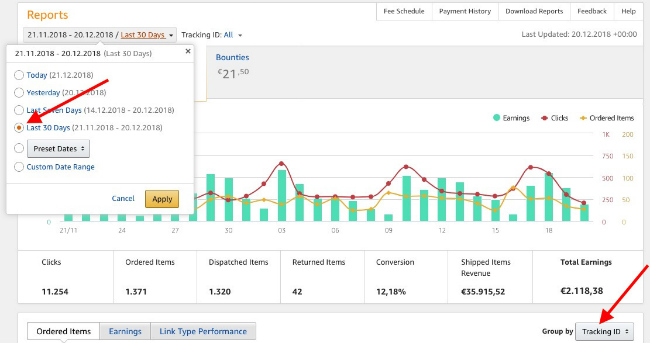If you are reading this article, chances are you are already a member of the Amazon Affiliate program and have been working on your affiliate content for some time. At this stage it is easy to feel somewhat stuck on how to make sense of your progress, how to see exactly which articles or pieces of content are having the highest impact on your earnings.
Perhaps you already have a website, blog or social media platform where you share content about products on Amazon. The first and most important area to start with when trying to scale your business is to ensure you are utilizing the tracking data as efficiently as possible.
If you want to successfully grow your traffic, you MUST know what type of content gets the most engagement and purchases. It can be a little tricky to decipher all the information Amazon gives you in regards to tracking your affiliate commission and what type of posts are working best for you. This is because the Associates Dashboard does not always give you a clear answer to how your specific pieces of content perform. Thankfully, we have experience setting this up which can help you!
By the end of this article, you’ll walk away with the knowledge to successfully analyze your tracking data in a few simple steps. Let’s get started!
Contents
What Is Tracking ID in Amazon Affiliate?
As an Amazon Affiliate marketer, you are able to create unique tracking ID’s to identify the different platforms you advertise on. For example, let’s say my Associates ID is reviewbusiness-20. If I advertise products within my blog, I could make sure those Amazon affiliate links all use the tracking ID reviewbusinessblog-20.
If I also advertise products on Instagram, I could ensure those links all use the ID reviewbusinessinsta-20
Both options are contributed to your one Associate Account, but the great thing is, you can see how many purchases come from your blog and how many come from your instagram individually.
Of course, you can combine the data together and see how many sales you made collectively across all platforms, but it’s useful to see where you are gaining the most traction.
What You Can See In Amazon Associates’ Standard Reports?
To find your reports, log into Amazon Associates Central and click on overview. This will automatically show you a snapshot of your earnings and spending (on any ads) in the past 30 days. You will see a graph that will demonstrate the 30 day data of the Amazon sales made.
In addition to the graph, you will see key statistics such as earnings total, conversion rate, total number of orders, and number of clicks and sales. If you want to view your stats in more detail, click on View Full Report. You will be able to view key items and earnings by tracking your progress within the reports.
When the full report is selected, you will be able to choose the time period you want to view – options include today, yesterday, last 7 days, last 30 days or custom date range. You are also able to view key figures such as the number of items returned and dispatched.
In the bottom right corner, you will be able to select Group Tracking ID. This feature allows you to switch between the different tracking IDs that we spoke about earlier. Meaning you are able to view graphs and data for each platform individually, as well as a whole.
How do I Create a New Tracking ID
If you want to create or use a new one so you can differentiate between your separate platforms, then the process is pretty simple:
- Head to Account Settings
- Click on Manage Tracking IDs.
- Here you will see a button named Add Tracking ID which will allow you to create a new Amazon tracking ID.
- Next, type the tracking code you want to use and use the search function to ensure that ID has not been used before by somebody else.
-
Amazon allows each affiliate to generate 100 unique IDs. If you ever need more, you will have to request this via Amazon’s customer service. But realistically, you shouldn’t be needing more than 100 if you use the IDs strategically.
It would be great if each new blog or article you write is able to have its own ID, but with the 100 link limit, that wouldn’t be an efficient use of your time. Instead, we suggest you break the links down firstly by platform.
A good rule of thumb when naming each tracking ID is to make sure you are as specific as possible. This will make your life easier when you are analyzing your sales data later on. An example how I would name my tracking links could look like this:
Facebook – reviewbusinessFB-20
Instagram – reviewbusinessinsta-20
Blog posts – reviewbusinessblog-20
Aside from separate tracking IDs for platforms, you may also want to track link placement in several blogs, or maybe you want to test if image links or text links perform better. Or perhaps you want to test different call-to-actions or carry out some A/B testing. In this case, you could create links for those tests as well.
If there is a special blog post you want to track individually, of course you can create a unique ID for this.
When do I Need Tracking IDs?
The reason you need tracking IDs is so that you can see what sales are attributed to which platform or blog. Affiliate tracking allows you to test your affiliate marketing results. This is important because it will help you understand what type of content or platform your customers or readers resonate with the most.
Once you understand this, you will be able to use that to your advantage and focus on creating content that is driving the most traffic and generating the most sales.
What exactly can I track with the Tracking ID?
With a unique ID you will be able to track common terms such as the number of: clicks to that location, ordered items, shipped items and returned items. You will also be able to view the conversion rate as a percentage, amount of revenue and total earnings.
What’s the Difference Between a Tracking ID and an Amazon Associates Store ID?
All Amazon Associates accounts are given a Store ID, which is the generic identification for your entire affiliate account. This is essentially how Amazon identifies your account. Think of this as your username. The tracking IDs are the individual links you will generate to track the data collected from a certain platform or post.
How to Analyze Multiple Tracking IDs
You can create multiple Amazon tracking IDs in the Manage your IDs tab. As a member of the affiliate network, you are able to analyze each new Amazon associates tracking ID within the reports dashboard. As mentioned earlier, you can select group tracking IDs to analyze their data as a whole, or individually.
What Can I Use To Track Sales On Amazon Made Using My New Tracking ID?
To track all sales and data relating to each ID, you must visit the Amazon Associates dashboard where you will see all your reports and analytics. The reports are customizable in that you can choose with ID to track, or you can track your Amazon account progress as a whole across all your links.
To view them individually, simply select the ID you want to analyze, and take a look at the populated data.
How to Delete My Tracking IDs
You can delete Amazon affiliate tracking IDs by going to Manage your Tracking ID and selecting the IDs you want to get rid of.







